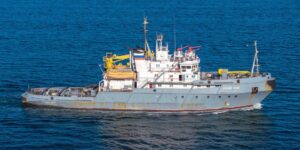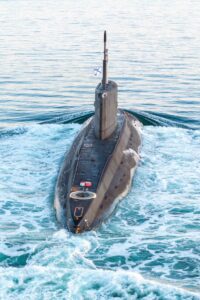Return to the Baltic Sea
On 7 May 2025, the Russian submarine "Krasnodar" (B-265), a boat of the improved Kilo class (project 636.3, Russian "Varshavyanka"), passed the Danish straits together with the deep-sea tug "Evgeniy Churov" (SB-921) heading for the Baltic Sea. A few days later, the unit arrived at its home port of Kronstadt as planned. The escort unit of the Sliva class, belonging to the Baltic Fleet (correction 29.05.25), left the Baltic again southwards on 11 May and was last in the Bay of Biscay.
The return of the "Krasnodar" marks the end of a Mediterranean deployment lasting just under three months - a deployment period that can be considered the upper limit for diesel-electric submarines without access to stationary logistics in the operations room. Remarkably, the boat was not replaced by another unit, although this was common practice in previous rotations.

Moscow's Mediterranean dilemma
With the withdrawal of the "Krasnodar", the Russian Navy is losing two of its strategically more important capabilities in the Mediterranean: the covert underwater presence and a submarine with cruise missiles. At the beginning of May 2025, the Russian contingent in the region only consisted of the frigate "Admiral Grigorovich" off Syria, the corvette "Soobrazitelny" in Alexandria and three auxiliary vessels, the supply ship "Kola", the fleet tanker "Vyazma" off Sicily and the reconnaissance ship "Viktor Leonov". In the years up to 2022, the Russian Eskadra in the Mediterranean was usually twice as strong and almost continuously equipped with at least one Kilo-class submarine.
Since the political change of power in Syria and the gradual withdrawal from Tartus, the Russian navy has lacked a reliable Mediterranean base. Added to this is the de facto exclusion of Russian warships from the Turkish straits due to the war in Ukraine, which prevents reinforcements from the Black Sea. Deployments are therefore made from the North Sea and the Baltic Sea - with correspondingly longer marching routes and increased logistical dependency.
Operational challenges and improvised care
The supply situation for the remaining units in the Mediterranean is correspondingly difficult. This means considerable restrictions, particularly for submarines such as the "Krasnodar", which are dependent on external logistics for longer missions. In March 2025, for example, an improvised fuel supply for the "Krasnodar" was observed at sea off the coast of Algeria. The previously common use of mobile workshop ships - such as the Amur-class "PM-82" - has also been cancelled since their withdrawal from Tartus at the beginning of 2024. This means that there is not only no fixed harbour base in the Mediterranean, but also no mobile maintenance capability.
It is also worth noting that the "Krasnodar" carried out a ten-day operation in the Kattegat in the Baltic Sea in January 2025 together with the submarine supply vessel "Sergey Balk". This operation also relied on close support and logistical security - a pattern that continued in the Mediterranean deployment.

Strategic evaluation
It is too early to say whether the redeployment of the "Krasnodar" marks a reorientation of Russian naval activities. However, the ability to sustainably project a maritime presence in distant sea areas has clearly diminished. Without a fixed base and without supplies from the Black Sea, it hardly seems possible to maintain submarine operations in the Mediterranean in the long term. Capabilities for covert situational awareness and underwater deterrence - once key elements of the Russian presence - are therefore largely redundant.
From a western perspective, this significantly reduces the underwater threat in the Mediterranean. Observers are already drawing comparisons with the lowest alert level - DEFCON 5 - which symbolises the strategic relaxation in the underwater segment. However, the return of the "Krasnodar" by no means means deactivation, but merely a relocation. After its stay in Kronstadt, the boat will be ready for deployment in its home waters. An additional Kilo-class submarine increases the threat potential, particularly in the Baltic Sea, where Moscow prioritises its operations.
It remains to be seen whether the withdrawal of the "Krasnodar" will be accompanied by a permanent reduction in the Russian submarine presence in the Mediterranean. If Tartus cannot be re-established as a stable backstop, new logistics options - for example in Libya or Algeria - could be sought. Observers are already talking about a possible "Libya Express"as the successor to the stalled "Syria Express".











4 responses
Moin,
where the information comes from that the salvage tug of the "Sliva" class SB-921 "Yevgeniy Churov" ("Евгений Чуров") belongs to the Russian Northern Fleet is a mystery to me.
Since entering service on 5 July 1985, the "SB-921" (later renamed "Yevgeniy Churov" ("Евгений Чуров") has been at home in the Baltic Fleet with its home port of Baltiysk. There is also a tugboat of this class, which was built in Finland at the time, in each of the other fleets:
- In the northern fleet there is the "SB-406",
- in the Black Sea Fleet the "SB-922" (since 4 October 1988 "Shakhter" ["Шахтёр"]) and
- the "SB-408" in the Pacific fleet.
Hello Mr Engel,
You are of course correct with your reference - the "Churov" is assigned to the Baltic Fleet as a salvage tug. This can also be read in Jane's. The article will be corrected accordingly.
Many thanks from the editorial team.
Moin,
where the information comes from that the salvage tug of the "Sliva" class SB-921 "Yevgeniy Churov" ("Евгений Чуров") belongs to the Russian Northern Fleet is a mystery to me.
Since entering service on 5 July 1985, the "SB-921" (later renamed "Yevgeniy Churov" ("Евгений Чуров") has been at home in the Baltic Fleet with its home port of Baltiysk. There is also a tugboat of this class, which was built in Finland at the time, in each of the other fleets:
- In the northern fleet there is the "SB-406",
- in the Black Sea Fleet the "SB-922" (since 4 October 1988 "Shakhter" ["Шахтёр"]) and
- the "SB-408" in the Pacific fleet.
Hello Mr Engel,
You are of course correct with your reference - the "Churov" is assigned to the Baltic Fleet as a salvage tug. This can also be read in Jane's. The article will be corrected accordingly.
Many thanks from the editorial team.